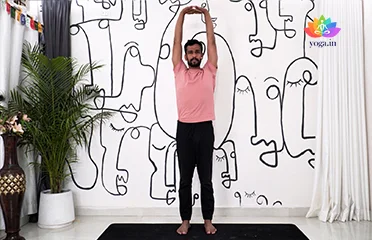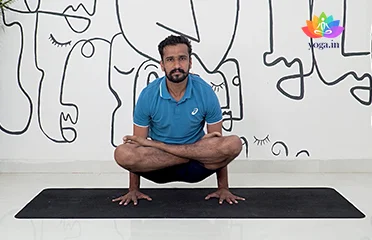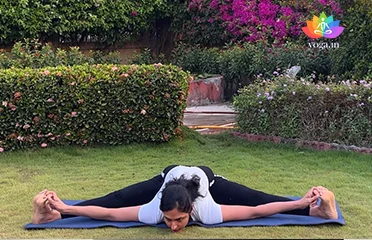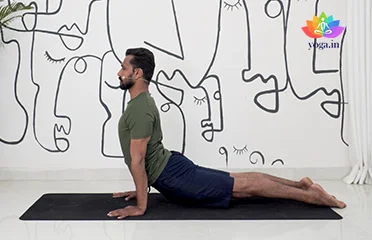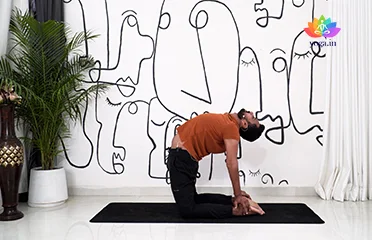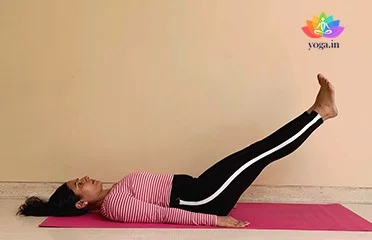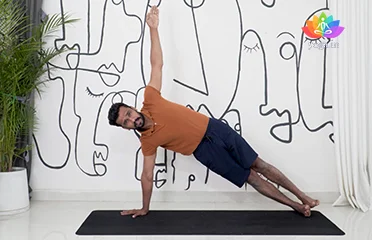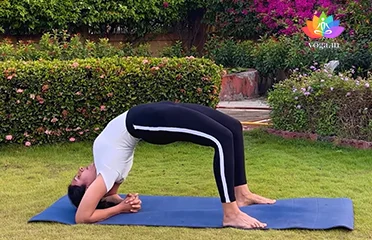Tadasana (Mountain Pose)
ताड़ासन / Mountain Pose
The sanskrit name is derived from tada (ताड़ा) meaning mountain and [�K]
Tittibhasana (Firefly Pose)
तिट्टीभासन / Firefly Pose
The Sanskrit name is derived from Tittibha (तिट्टीभा) meaning [�K]
Trikonasana (Triangle Pose)
त्रिकोणासन / Triangle Pose
The sanskrit name is derived from three Sanskrit Words: Tri (त्रि) meaning [�K]
Tulasana (Scale Pose)
तुलासन / Scale Pose
The Sanskrit name is derived from Tula (तुला) meaning balance and asana [�K]
Upavishta Konasana (Wide-Angled Seated F
उपविष्ट कोनासन / Wide-Angled Seated Forward Bend
The Sanskrit name is derived from Upavistha (उपविष्ट) means open/seated, [�K]
Urdhva Mukha Svanasana (Upward-Facing Do
ऊर्ध्वमुखश्वानासन / Upward-Facing Dog Pose
The Sanskrit name is derived from Urdhva (ऊर्ध्व) meaning up, Mukha [�K]
Ushtrasana (Camel Pose)
उष्ट्रासनI / Camel Pose
The Sanskrit name is derived from Ushtra (उष्ट्रासनI) meaning [�K]
Uttanapadasana (Raised Leg Pose)
उत्तान पादासन / Raised Leg Pose
In Sanskrit, Uttana means 'raised', and pada means 'leg'; thus, Uttanpadasana [�K]
Vasishtasana (Side Plank Pose)
वसिष्ठासन / Side Plank Pose
The Sanskrit name is derived from Vasistha (वसिष्ठा) meaning wealthy [�K]
Viparita Dandasana (Inverted Staff Pose)
विपरिता दण्डासन / Inverted Staff Pose
The Sanskrit name is derived from Viparita (विपरिता) meaning inverted, [�K]
- 1
- 2
- 3
- 4
- 5
- 6
How Yoga Can Help:
Cervical spondylosis is a common condition characterized by degeneration of the discs and joints in the neck. Yoga can significantly help in treating and relieving the symptoms of cervical spondylosis by improving flexibility, strengthening the neck muscles, and enhancing blood circulation. Through targeted yoga poses and breathing exercises, yoga can alleviate pain, reduce stiffness, and promote overall neck health.
Understanding Yoga Poses for Cervical Spondylosis:
Yoga poses for cervical spondylosis focus on gentle stretching and strengthening of the neck and shoulder region. These poses are designed to improve posture, enhance mobility, and reduce the pressure on the cervical spine. Understanding these poses involves recognizing their benefits in promoting a healthy and pain-free neck.
Yoga’s Role in Relieving Cervical Spondylosis:
Yoga plays a crucial role in relieving cervical spondylosis by offering specific practices and techniques that target the affected areas. These include gentle asanas (postures) that stretch and strengthen the neck muscles, pranayama (breathing exercises) that reduce tension and improve circulation, and meditation that promotes relaxation and stress relief.
Key Factors Contributing to Cervical Spondylosis:
Several factors can contribute to the development of cervical spondylosis, including:
- Age: Natural wear and tear of the cervical spine as we age.
- Poor Posture: Prolonged sitting or standing in incorrect postures.
- Injury: Previous neck injuries or trauma.
- Sedentary Lifestyle: Lack of physical activity leading to weakened neck muscles.
- Genetics: Family history of cervical spondylosis.
Symptoms of Cervical Spondylosis:
Common symptoms associated with cervical spondylosis include:
- Neck Pain: Persistent or intermittent pain in the neck region.
- Stiffness: Reduced flexibility and difficulty moving the neck.
- Headaches: Pain that radiates from the neck to the head.
- Numbness: Tingling or numbness in the shoulders, arms, or hands.
- Weakness: Muscle weakness in the arms or legs.
Treatment of Cervical Spondylosis through Yoga and Pranayama:
Yoga and pranayama can be very beneficial in managing cervical spondylosis. Some effective practices include:
Specific Yoga Poses:
- Bhujangasana (Cobra Pose): Strengthens the neck and spine.
- Marjariasana (Cat-Cow Pose): Enhances flexibility and relieves tension.
- Setu Bandhasana (Bridge Pose): Strengthens the neck and back.
Pranayama Exercises:
- Nadi Shodhana (Alternate Nostril Breathing): Balances energy and reduces stress.
- Sheetali Pranayama (Cooling Breath): Calms the mind and reduces heat in the body.
Diet for Cervical Spondylosis:
A balanced diet can help manage cervical spondylosis. Recommendations include:
- Anti-inflammatory Foods: Include foods like turmeric, ginger, and green leafy vegetables.
- Calcium-Rich Foods: Dairy products, almonds, and leafy greens to strengthen bones.
- Hydration: Drink plenty of water to keep discs hydrated.
- Vitamin D: Ensure adequate sunlight exposure or include supplements for bone health.
Caution for Cervical Spondylosis:
While practicing yoga for cervical spondylosis, it is essential to:
- Avoid Overexertion: Do not push yourself too hard; practice at a comfortable pace.
- Be Mindful of Pain: Stop immediately if you experience any pain or discomfort.
- Seek Guidance: Work with a knowledgeable yoga instructor or therapist experienced in cervical issues.
Contraindications for Cervical Spondylosis:
Individuals with severe symptoms or underlying health conditions should:
- Avoid High-Intensity Yoga: Vigorous practices might be overwhelming and counterproductive.
- Steer Clear of Certain Poses: Avoid poses that put strain on the neck.
- Seek Professional Guidance: Consult a healthcare provider or yoga therapist for personalized recommendations.


